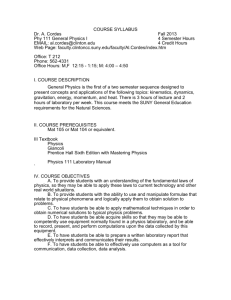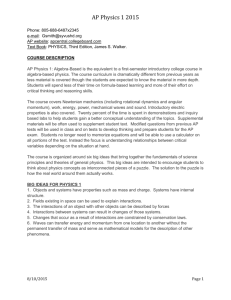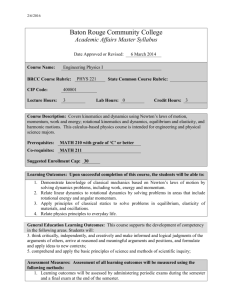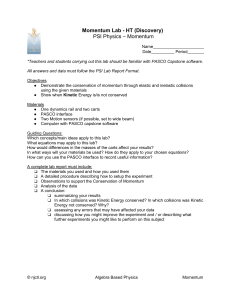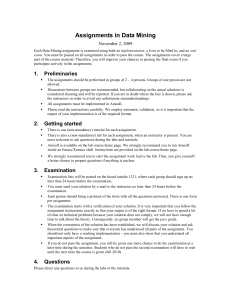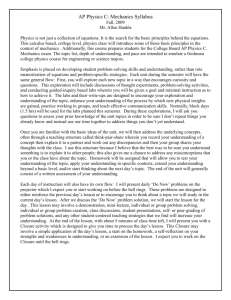AP PHYSICS C- Mechanics syllabus
advertisement
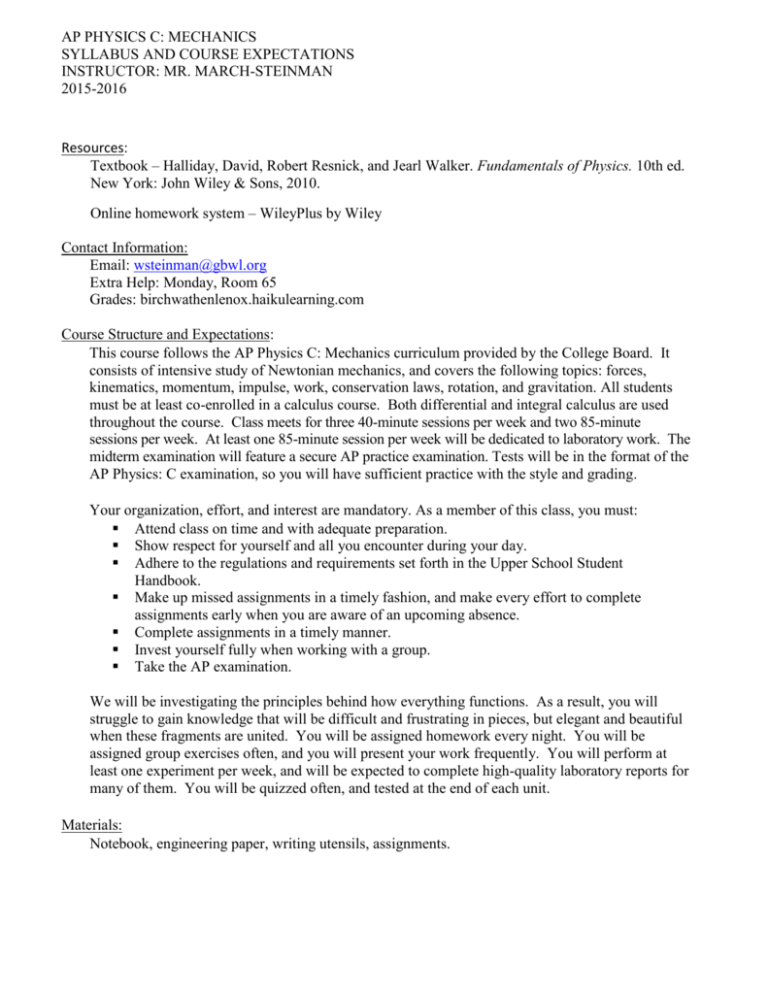
AP PHYSICS C: MECHANICS SYLLABUS AND COURSE EXPECTATIONS INSTRUCTOR: MR. MARCH-STEINMAN 2015-2016 Resources: Textbook – Halliday, David, Robert Resnick, and Jearl Walker. Fundamentals of Physics. 10th ed. New York: John Wiley & Sons, 2010. Online homework system – WileyPlus by Wiley Contact Information: Email: wsteinman@gbwl.org Extra Help: Monday, Room 65 Grades: birchwathenlenox.haikulearning.com Course Structure and Expectations: This course follows the AP Physics C: Mechanics curriculum provided by the College Board. It consists of intensive study of Newtonian mechanics, and covers the following topics: forces, kinematics, momentum, impulse, work, conservation laws, rotation, and gravitation. All students must be at least co-enrolled in a calculus course. Both differential and integral calculus are used throughout the course. Class meets for three 40-minute sessions per week and two 85-minute sessions per week. At least one 85-minute session per week will be dedicated to laboratory work. The midterm examination will feature a secure AP practice examination. Tests will be in the format of the AP Physics: C examination, so you will have sufficient practice with the style and grading. Your organization, effort, and interest are mandatory. As a member of this class, you must: Attend class on time and with adequate preparation. Show respect for yourself and all you encounter during your day. Adhere to the regulations and requirements set forth in the Upper School Student Handbook. Make up missed assignments in a timely fashion, and make every effort to complete assignments early when you are aware of an upcoming absence. Complete assignments in a timely manner. Invest yourself fully when working with a group. Take the AP examination. We will be investigating the principles behind how everything functions. As a result, you will struggle to gain knowledge that will be difficult and frustrating in pieces, but elegant and beautiful when these fragments are united. You will be assigned homework every night. You will be assigned group exercises often, and you will present your work frequently. You will perform at least one experiment per week, and will be expected to complete high-quality laboratory reports for many of them. You will be quizzed often, and tested at the end of each unit. Materials: Notebook, engineering paper, writing utensils, assignments. Grading: The grading scale is based on the Upper School handbook. Homework: 15% Homework will largely be assigned through WileyPlus. We will go over how to access this service in class. You may also be assigned homework in other formats. Homework will be posted to Haiku, and given in class. Homework is worth 10 points, and is due at the beginning of class. Late homework will receive half credit. Labs/Recitations: 25% Laboratory reports and assignments will be given weekly. Each laboratory experiment will require extensive analysis. Some will require full, formal reports. You will be provided guidelines with each experiment. You are expected to keep a portfolio of these reports throughout the year. Two main aspects of laboratory analysis will be equation derivation and graph linearization. All calculations, derivations, and graphs must be completed manually on the engineering paper that you will be provided with. Late laboratory work will receive half credit. Recitations involve group exercises that will be completed outside of class and presented in class upon submission. Recitation presentations will be assigned in random order, and will be graded through peer and instructor review. Late recitation work will receive no credit. Tests/Quizzes: 60% Quizzes will be unannounced and will focus on concepts, readings, and labs. Tests will be given at the end of each unit. All tests are cumulative. Tests will be formatted in the same manner as the AP examination, and will be graded using AP free-response rubrics. You will be exposed to how examinations are scored using anonymous free-response samples and official rubrics. You must make up a test or quiz within one week to receive credit. Academic Honesty: I expect all work you complete to be entirely a result of your own effort. Any sources you use for information must be cited clearly and consistently, through the use of both in-text citations and a bibliography. Any deviation from this requirement will result in severe consequences, detailed within the student handbook. Your calculations must be your own, as must your analysis. All group members should put forth their best efforts when completing assignments together. AP Examination: All students enrolled in the course are expected to take the AP examination. The test will be held on the afternoon of Monday, May 9th. We will have covered all content by the end of April, and will use the final two weeks to review for the assessment. If students agree, Saturday review sessions will also be available during this time. STUDENT CONTRACT: I, ___________________________, have read this expectation sheet and understand what is expected in this class. I will adhere to the code of conduct, and will commit to taking the AP examination in May. _____________________________________________ (Student's signature) _____________________________________________ (Parent/Guardian's signature) Date:______________ Date:_____________ Unit 01 (4 weeks) Labs: Static Equilibrium Static and Kinetic Friction Friction on an incline Forces in Equilibrium and the Nature of Friction Topics: Vector addition, components, Newton’s 3 Laws, compound systems, static and kinetic friction Unit 02 (5 weeks) Labs: Instantaneous velocity Kinematics in 1- and 2-Dimensions Topics: Position, velocity, and acceleration w/ calculus, graphs of motion – slopes and areas; independence of 2-D components; projectiles in freefall; circular motion – both uniform & variable Lunar Lander (PhET sim) PASCO Projectile Launcher – 3 ring challenge Flying Pigs Unit 03 (3 weeks) Labs: PASCO Launcher II: Launcher Spring constant Cart-Force probe collision impulse Unit 04 (4 weeks) Labs: Mass of meter stick from system CoM Interactions Smorgasbord – recoil, elastic, partially elastic, completely inelastic scenarios Unit 05 (4 weeks) Labs: Smart pulley rotational acceleration PVC Pipe armature rotational inertia Rolling objects inertia PASCO Launcher into PVC Armature Unit 06 (4 weeks) Labs: My Solar System “G” (PhET sim) Bouncing vertical oscillator energy Exam Review (2 weeks) Impulse & work Momentum & Kinetic energy Topics: Impulse/momentum th’m development and applications; varying mass scenarios – rocket thrust; work/kinetic energy th’m development and applications; def’n of power (All above w/ calculus) Conservation of Momentum and Energy Topics: Potential energy defined from conservative force functions; center of mass of compound systems; system momentum defined; recoil, inelastic, and elastic interactions Rotation Topics: Rotational kinematics, rotational kinetic energy and inertia, rotational dynamics, rolling w/o slipping, net torque and angular momentum, conservation of angular momentum, rolling w/ slipping Law of Universal Gravitation and Harmonic Motion Topics: LUG kinematics and dynamics of circular orbits; LUG energetics and angular momentum of circular and elliptical orbits; SHM kinematics and dynamics; harmonic motion energetics and non-Hookean oscillators (weak damping, torsional & physical pendula)

